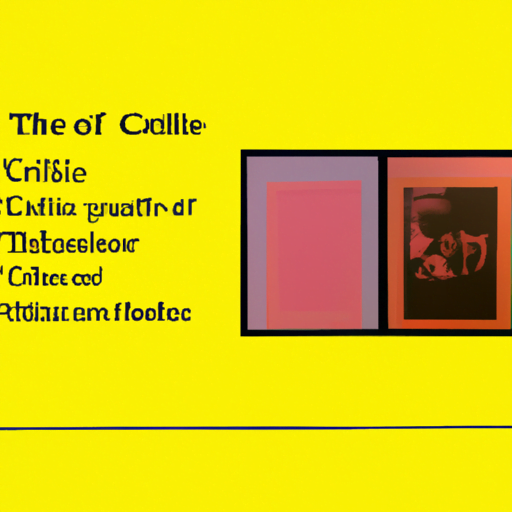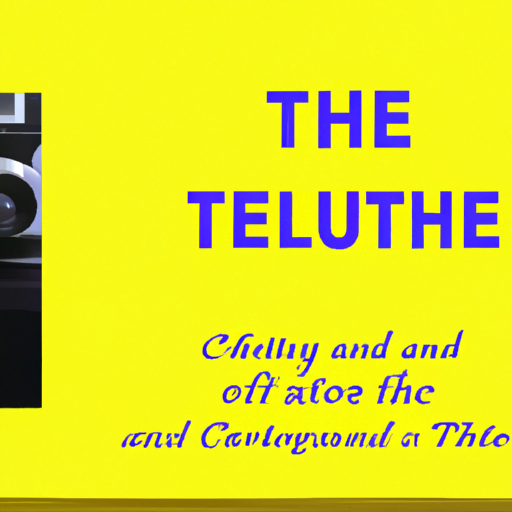
-
Table of Contents
- The Influence of Typography in Exhibition Catalogs
- The Power of Typography
- The Role of Typography in Exhibition Catalogs
- Setting the Tone and Mood
- Guiding the Reader’s Attention
- Enhancing Readability and Comprehension
- Creating a Visual Hierarchy
- Establishing a Brand Identity
- Case Studies: The Impact of Typography in Exhibition Catalogs
- Case Study 1: “Modern Masters: Monet to Matisse”
- Case Study 2: “The Art of Ancient Egypt”
- Key Takeaways
The Influence of Typography in Exhibition Catalogs

Typography plays a crucial role in the design and effectiveness of exhibition catalogs. It is not just about choosing the right font; it is about creating a visual language that enhances the overall experience for the reader. In this article, we will explore the influence of typography in exhibition catalogs and how it can impact the way information is communicated and perceived.
The Power of Typography
Typography is more than just the selection of fonts; it is the art and technique of arranging type to make written language legible, readable, and visually appealing. In the context of exhibition catalogs, typography serves as a powerful tool to convey information, evoke emotions, and create a cohesive visual identity.
Typography has the ability to:
- Set the tone and mood of the exhibition
- Guide the reader’s attention
- Enhance readability and comprehension
- Create a visual hierarchy
- Establish a brand identity
The Role of Typography in Exhibition Catalogs
Exhibition catalogs serve as a tangible representation of an exhibition, providing visitors with a lasting memory and a way to revisit the experience. Typography plays a crucial role in shaping the overall impression and effectiveness of these catalogs.
Setting the Tone and Mood
The choice of typography sets the tone and mood of the exhibition. Whether it is a bold and modern font for a contemporary art exhibition or a classic serif font for a historical exhibition, typography helps to establish the visual language that aligns with the theme and atmosphere of the exhibition.
For example, the use of a clean and minimalist sans-serif font can convey a sense of modernity and simplicity, while a decorative and ornate serif font can evoke a feeling of elegance and tradition.
Guiding the Reader’s Attention
Typography can guide the reader’s attention and help them navigate through the content of the exhibition catalog. By using different font sizes, weights, and styles, important information can be emphasized and stand out from the rest of the text.
For instance, headings and subheadings can be set in a larger and bolder font to draw attention to key sections or themes. Pull quotes and captions can be styled differently to highlight important quotes or descriptions. By strategically using typography, exhibition catalogs can effectively guide the reader’s attention and enhance their overall reading experience.
Enhancing Readability and Comprehension
Typography plays a crucial role in enhancing the readability and comprehension of exhibition catalogs. The choice of font, line spacing, and paragraph spacing can significantly impact how easily the text can be read and understood.
Studies have shown that serif fonts, such as Times New Roman, are generally easier to read in print, while sans-serif fonts, such as Arial, are more legible on screens. Exhibition catalogs should consider the medium in which they will be consumed and choose a font that maximizes readability.
Additionally, proper line spacing and paragraph spacing can improve the overall reading experience by providing enough visual breathing space between lines and paragraphs. This allows the reader to process the information more easily and prevents the text from appearing cluttered or overwhelming.
Creating a Visual Hierarchy
Typography helps to create a visual hierarchy within exhibition catalogs, allowing the reader to quickly scan and understand the content. By using different font sizes, weights, and styles, important information can be visually prioritized.
For example, exhibition catalogs often use larger and bolder fonts for titles and headings, while body text is set in a smaller and lighter font. This contrast in typography creates a clear visual hierarchy, making it easier for the reader to navigate through the catalog and find the information they are looking for.
Establishing a Brand Identity
Exhibition catalogs are not just a collection of information; they are also a representation of the exhibition and its brand. Typography plays a crucial role in establishing a consistent and recognizable brand identity.
By using consistent typography across all exhibition materials, including catalogs, posters, and signage, a cohesive visual identity can be created. This helps to reinforce the exhibition’s brand and make it more memorable for visitors.
Case Studies: The Impact of Typography in Exhibition Catalogs
Let’s explore two case studies that demonstrate the influence of typography in exhibition catalogs:
Case Study 1: “Modern Masters: Monet to Matisse”
In the exhibition catalog for “Modern Masters: Monet to Matisse,” typography played a crucial role in setting the tone and mood of the exhibition. The catalog used a combination of a clean and modern sans-serif font for headings and a classic serif font for body text.
The use of the sans-serif font for headings conveyed a sense of modernity and innovation, aligning with the theme of the exhibition, which showcased the works of groundbreaking artists. On the other hand, the serif font for body text added a touch of elegance and sophistication, reflecting the timeless beauty of the artworks.
The typography in this exhibition catalog effectively guided the reader’s attention and enhanced readability. Important information, such as artist names and artwork titles, were set in a larger and bolder font, making them stand out from the rest of the text. The use of proper line spacing and paragraph spacing also improved the overall reading experience.
Case Study 2: “The Art of Ancient Egypt”
In the exhibition catalog for “The Art of Ancient Egypt,” typography played a crucial role in creating a visual hierarchy and establishing a brand identity. The catalog used a combination of a decorative serif font for headings and a simple sans-serif font for body text.
The use of the decorative serif font for headings added a sense of grandeur and authenticity, reflecting the ancient Egyptian art showcased in the exhibition. On the other hand, the simple sans-serif font for body text ensured readability and provided a clean and modern contrast to the ornate headings.
The typography in this exhibition catalog effectively created a visual hierarchy by using larger and bolder fonts for headings and smaller fonts for body text. This allowed the reader to quickly scan and understand the content. Additionally, the consistent use of typography across all exhibition materials helped to establish a strong and recognizable brand identity.
Key Takeaways
Typography plays a crucial role in exhibition catalogs, influencing the overall impression and effectiveness of these publications. Here are the key takeaways:
- Typography sets the tone and mood of the exhibition.
- Typography guides the reader’s attention and enhances readability.
- Typography creates a visual hierarchy and establishes a brand identity.
- Consider the medium in which the catalog will be consumed when choosing fonts.
- Use different font sizes, weights, and styles to prioritize important information.
<
